The world is facing a devastating pandemic, caused by SARS-CoV-2. It causes secondary infections like fungal (Candida infections), rare mould infections (fusariosis) and COVID-19- associated mucormycosis are likely to be under-reported. The risk factors predisposing patients to mucormycosis are uncontrolled diabetes, neutropenia, haematological malignancies, organ transplantation, trauma and burn, and use of immunosuppressants such as corticosteroids. Furthermore, diabetes is also a particularly important comorbidity complicating COVID-19 management (1). 56.25% COVID-19 patients with Mucormycosis have maxillectomy (2). To rehabilitate the patients there comes the role of maxillofacial prosthesis, usually PMMA (poly methyl methacrylate) is used as a definitive prosthesis but flexible dentures are an excellent alternative to conventionally used methyl methacrylate dentures, which not only provide excellent aesthetics and comfort but also adapt to the constant movement and flexibility in partially edentulous patients (3). It has an improved esthetics because the translucency of the material picks up underlying tissue tones, making it almost impossible to detect in the mouth. No clasping is visible on tooth surfaces (when used in manufacturing of clear clasps). It is a biocompatible material because the material is free of monomer and metal. Flexible dentures will not cause sore spots due to negative reaction to acrylic resins and will absorb small amounts of water to make the denture more soft tissue compatible (4). Considering these advantages, the flexible dentures are used as a choice of material for rehabilitating partial maxillectomy patient who were previously affected by mucormycosis.
CASE HISTORY
Chief complaint – A 48Year old male patient reported to the clinic with a chief complaint of leakage of water, liquids and food through nose, inability to chew food and nasal twang in speech. Past medical history- Patient had COVID-19 and he is known diabetic (Type-2). He was diagnosed with mucormycosis and underwent partial maxillectomy before 3 months. Past dental history- Patient was wearing an intermediate obturator made of PMMA. Diagnosis- Partial Edentulous Treatment planned- Flexible denture was advised.

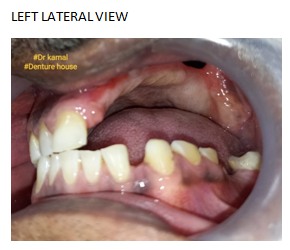 CLINICAL STEPS Upper and lower alginate impression was made. Denture base was fabricated and occlusal rims made Jaw relation and wax trail was done Flexible partial denture was fabricated After insertion of prosthesis, postoperative instruction were given Follow was done at an interval of 24hours, 1week, 1month, 3months, 6months and one year.
CLINICAL STEPS Upper and lower alginate impression was made. Denture base was fabricated and occlusal rims made Jaw relation and wax trail was done Flexible partial denture was fabricated After insertion of prosthesis, postoperative instruction were given Follow was done at an interval of 24hours, 1week, 1month, 3months, 6months and one year.
POST OPERATIVE IMAGES
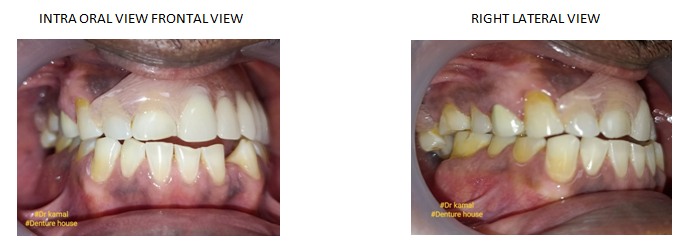
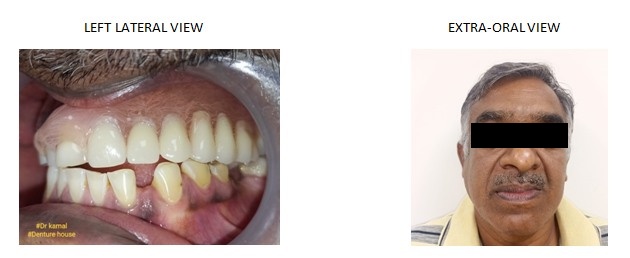
DISCUSSION:
The goals of prosthetic rehabilitation for maxillectomy patients include helping in deglutition and articulation by adequate separation of the oral and nasal cavities, possible support of the orbital contents to prevent enophthalmos and diplopia, support of the soft tissues to restore the midfacial contour, and an acceptable esthetic result. A maxillofacial prosthesis intends to replace the missing oral or facial structures and its associated functions. The prosthesis constructed to rehabilitate the maxillary defect is termed as an obturator (5). Large maxillary defects are often associated with the loss of hard tissues including bone and teeth complicated with overlying soft tissue collapse. In such situations, the prosthetic obturators help in a great extent as they not only replace the defect portion but also provide masticatory and speech functions by replacing the teeth and natural anatomical form of the missing structures 6). A conventional obturator is typically fabricated using acrylic resin and a cobalt–chromium palatal framework, along with an acrylic hollow bulb, to decrease the weight of the prosthesis (5). In this case series for patients, we have used flexible denture base resin (Sunflex) for fabrication of maxillary obturator considering its superior properties. Because of its versatile nature it is exclusively used in partially edentulous arches. These flexible dentures stands aesthetically superior because they are more stain-resistant than other flexible acrylics. These dentures has the perfect degree of flexibility, it can be relined and repaired, these dentures will not warp or become brittle and it gives a good comfort for the patient (4). It has the flexibility to disengage forces on individual teeth and prevent transfer of forces to remaining natural teeth and the other side of the arch. Moreover, the material is light in weight, heat resistant, and ductile and is injected at a temperature of 274° to 300°C3. All the patients in this case series preferred flexible dentures over the customary methyl methacrylate dentures because they had bitter experience with their old dentures and this new material gave them hope for better quality of life. Their quality of life is improved by better speech, function and masticatory efficiency. In a study conducted by Clara et.al they state that there was improvement in the oral health related quality of life (OHRQoL) of patients with use of flexible partial dentures. Therefore, thermoplastic materials are possible alternative removable partial denture base materials in patient management (7).
CONCLUSION
Flexible obturator being biocompatible, light weight and mouldable proved to be an excellent material of choice for rehabilitation in this case.
REFERENCES:
1. Hoenigl M, Seidel D, Carvalho A, Rudramurthy SM, Arastehfar A, Gangneux JP, Nasir N, Bonifaz A, Araiza J, Klimko N, Serris A, Lagrou K, Meis JF, Cornely OA, Perfect JR, White PL, Chakrabarti A; ECMM and ISHAM collaborators. The emergence of COVID-19 associated mucormycosis: a review of cases from 18 countries. Lancet Microbe. 2022 Jul;3(7):e543-e552.
2. Mitra S, Janweja M, Sengupta A. Post-COVID-19 rhino-orbito-cerebral mucormycosis: a new addition to challenges in pandemic control. Eur Arch Otorhinolaryngol. 2022 May;279(5):2417-2422.
3. Singh JP, Dhiman RK, Bedi RP, Girish SH. Flexible denture base material: A viable alternative to conventional acrylic denture base material. Contemp Clin Dent. 2011 Oct;2(4):313-7.
4. Kaira, Laxman & Dayakara, H & Singh, Richa. (2012). Flexible Denture for Partially Edentulous Arches -A Case Report. journal of dentofacial sciences. 2. 39-42.
5. Ramasamy TV, Chandra J. An innovative sectional silicone obturator in a patient with partial maxillectomy: A Case report. J Indian Prosthodont Soc. 2020 JanMar;20(1):115-119.
6. Patil PG, Nimbalkar-Patil S. Lost wax-bolus technique to process closed hollow obturator with uniform wall thickness using single flasking procedure. J Indian Prosthodont Soc. 2017 Jan-Mar;17(1):84-88.
7. Akinyamoju CA, Dosumu OO, Taiwo JO, Ogunrinde TJ, Akinyamoju AO. Oral health related quality of life: acrylic versus flexible partial dentures. Ghana Med J. 2019 Jun;53(2):163-169.


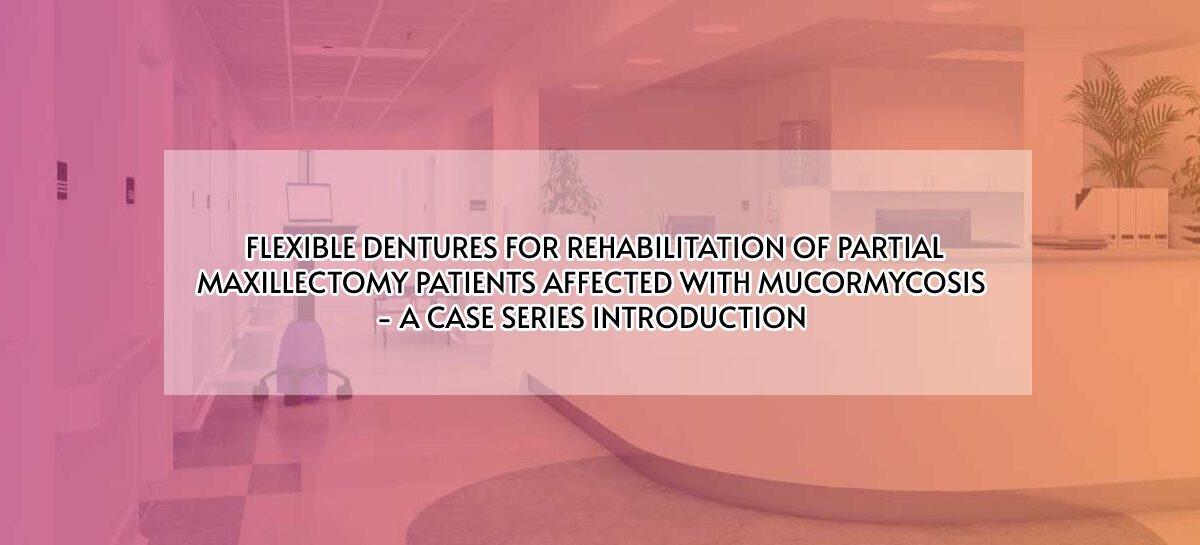
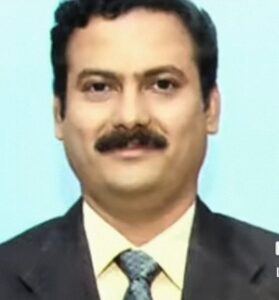 Dr. Kamala kannan
Dr. Kamala kannan